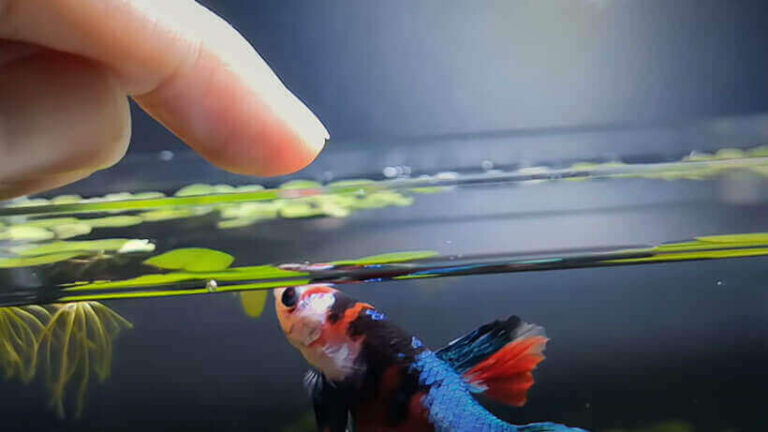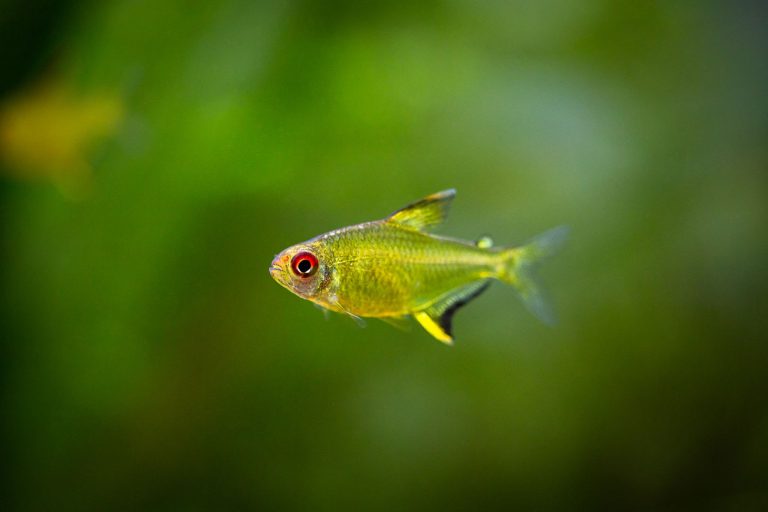Molly Fish Guide: Care, Birth
The molly fish is a tropical freshwater fish species that is common and popular in aquarium shops. Due to its ease of care, frequent breeding, affordable prices, and beautiful colors, it has managed to be among the top choices for many hobbyists.
Although the care of molly fish is simple, there are things that those new to the hobby must definitely learn. Therefore, we strongly recommend reading this molly fish guide we’ve created to take good care of mollies and keep them healthy.
Molly Fish Species Summary
| Scientific Name: | Poecilia sphenops |
| Origin: | Central America and South America |
| Diet: | Omnivore |
| Behavior: | Peaceful |
| Behavior towards its own species: | Peaceful |
| Swimming Zone: | Middle, surface |
| Water Temperature: | 20°C – 28 °C |
| Water Hardness: | 15 – 30 dGH |
| pH Level: | 7.5 – 8.5 |
| Minimum Tank Volume: | 50 Liters |
| Adult Size: | 6 to 12 cm (Generally 6 cm, some species larger) |
| Reproduction: | Live-bearing |
| Lifespan: | 5 years |
| Care Level: | Easy |
Characteristics:
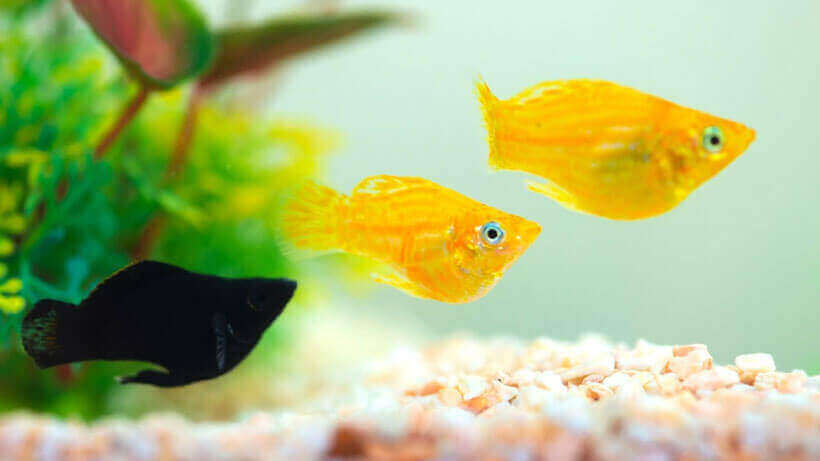
One of the first things that come to mind when molly fish characteristics are mentioned is their active behavior. Molly fish are aquarium fish species that live in the warm regions of tropical rivers and are notable for their bright colors.
Molly fish live in shoals and swim in a very active manner. Since these fish live in estuarial areas where rivers meet the sea – often referred to as brackish waters – they can tolerate water that contains a small amount of salt. In fact, some species are kept in saltwater aquariums. See: Velifera Molly Fish.
Appearance and Behavior
They commonly appear in yellow, orange, white, and black colors. In some species, a mix of these colors creates a wonderful pattern. Molly fish possess a long and slender body. Their backs have a slightly humped appearance. The fins of molly fish are generally large, long, and graceful. In some species, however, the fins might be shorter and more rounded.
By nature, mollies have peaceful behaviors and get along with other aquarium fish, especially other live-bearing species. On some occasions (usually during breeding periods), male molly fish might display aggressive behavior competing with other males, but this aggression is not intense enough to cause serious harm.
Mollies are also compatible with predatory aquarium fish species. However, certain fish species, especially aggressive ones like large cichlid species, might harm molly fish. Hence, if different fish types are to be kept in the aquarium, it’s essential to keep mollies with compatible species.
Natural Habitat
The natural habitats of molly fish are in certain regions of Central America (like Mexico) and the southern part of the USA. Mollies thrive in freshwater environments, but they also live in places like lagoons and brackish waters that contain salt.
Some species of mollies live and breed in shallow seas around harbor areas and mangrove roots. Molly fish have adapted to the wavy and flowing waters of their natural habitats. These challenging conditions contribute to their healthy growth and reproduction.
Molly Fish Gender Identification
Identifying the gender of a molly fish visually is straightforward. The fundamental differences between males and females include:
- Male molly fish typically have brighter colors compared to females.
- Males have longer and more flamboyant tail and dorsal fins.
- Female molly fish are wider and larger compared to males.
- The anal fins of males are sharp and V-shaped (with a gonopodium), while females have a rounder shape (without a gonopodium).
- Female molly fish have a dark spot in their abdominal region, known as the ovary area.
The following image illustrates the primary gender distinction between male and female molly fish by showing the gonopodium:
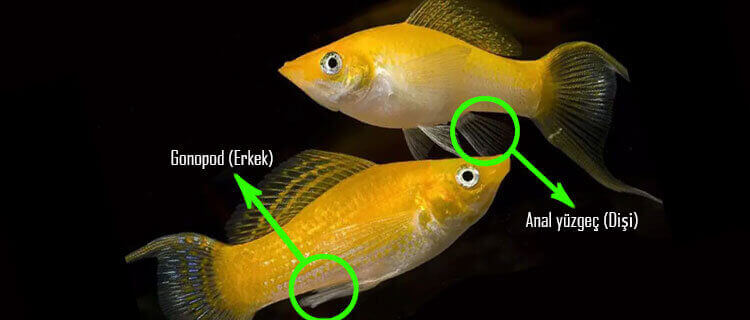
Molly Fish Compatibility:
Molly fish prefer to live in groups. It’s recommended to have at least 4 of them together. They can coexist with many peaceful species. It’s important to avoid aggressive tank mates.
They can coexist with:
- Southern platyfish
- Cherry Barb
- Rosy Barb
- Zebra Loach
- Bushymouth catfish and Oto cat
- Various Tetra species
- Panda corydoras
- Green swordtail
- Guppy
- Peaceful dwarf cichlid species
- Snail species
- Shrimp species
Types of Molly Fish:
As of now, there are 39 known molly species. Here are the most common and popular types:
Black Molly
The Black Molly fish has a dark black color with variations that can have orange, yellow, or white patterns on its body. It possesses a pointed nose and round caudal fin (tail fin). It’s one of the most commonly found and acquired molly species in pet stores.
Balloon Molly
The Balloon Molly is a variety of molly that emerged due to a mutation. As a result of a process that affects their spine, their bodies have taken on a balloon-like shape. They are generally seen in colors like yellow, black, and white. The mutation they have undergone affects their lifespan, with well-maintained balloon mollies living up to about 3 years.
Sailfin Molly
This species is known for its unique fins and is also referred to as the Velifera fish. Distinct from standard mollies, it has fins that resemble sails. They can exhibit all the colors that other mollies possess. Another striking characteristic that sets them apart from standard mollies is their behavior. The Velifera, known for its aggressive tendencies, is often compared to the Betta fish.
Lyretail Molly
The Lyretail Molly is named for its crescent-like caudal fin (tail fin) that resembles the shape of a lyre. They are aesthetically pleasing aquarium fish. Commonly, they come in silver, black, and yellow colors. To prevent any damage to their long and attention-grabbing tails, they should not be kept with fin-nipping fish.
Dalmatian Molly
The name ‘Dalmatian Molly’ doesn’t come from its shape but from its color and patterns. This variety of molly primarily has a white base color with black spots, reminiscent of Dalmatian dogs, hence the name. Varieties like the Lyretail and Sailfin Molly can have this Dalmatian appearance.
Molly Fish Care
One of the great aspects of Molly fish is their easy maintenance. They are suitable for almost everyone, including beginners. All you need to do is pay attention to their basic care requirements and enjoy watching them.
Aquarium
Mollies, which are among the smaller aquarium fish, do not require large-volume aquariums. As they are schooling fish, it is advisable to keep them in groups of at least four. A 50-liter (around 13 gallons) or larger aquarium would be sufficient for this number.
If you wish to keep more mollies, you should add 10 liters (approximately 2.6 gallons) of volume for each additional adult fish. During the aquarium setup, it’s essential to provide areas for the fish to swim and hide. Lastly, the mentioned aquarium volume is for standard mollies. If you’re going to keep larger varieties, like the Velifera, the aquarium size should be increased accordingly.
When setting up the aquarium, it is essential to ensure there are enough hiding spots. Mollies’ natural habitats are rich in rocks, roots, and plants. The closer you replicate their natural environment, the healthier and more content the fish will be.
Water Parameters
Mollies can live in various water conditions. While most live in freshwater, they can also survive in brackish water and, for short periods, in salty seawater. Although this might sound confusing, they do not require salty water to live; freshwater suits them perfectly.
The ideal water temperature should be kept stable around 23-24°C (73-75°F) for them to thrive. They generally prefer neutral pH levels and moderately hard waters. Below are the basic living water parameters:
- Water temperature: 20°C – 28°C (68°F – 82°F)
- Water hardness: 15 – 30 dGH
- pH level: 7.5 – 8.5
Feeding
Being omnivorous, mollies primarily feed on plant-based foods. Although they aren’t as efficient as some other algae-eating fish, they will consume some of the algae and other types of algae that form in the aquarium.
Molly Fish Food
While store-bought molly fish food might suffice, it’s recommended to also provide vegetables for healthier fish. They readily consume vegetables such as spinach, lettuce, peas, and zucchini. To ensure their well-being, you can purchase 2-3 types of food from the market, including flakes, granules, and tablet foods.
It’s strongly advised against using unbranded or unclearly sourced feeds. Such feeds not only harm the fish but can also spoil the aquarium water, leading to issues like increased nitrite levels and unpleasant odors.
How Should Molly Fish be Fed?
Adult molly fish should be fed twice daily. You can contribute to their digestive health by offering different molly foods for each meal. Additionally, as mentioned above, you can provide them with the specified vegetables, boiled for a few minutes (except for lettuce) and finely chopped. A good rule of thumb to determine the feeding amount is that if the fish finish their food within 2-3 minutes, it’s the right quantity.
How to Feed Molly Fish Fry?
Although molly fry care isn’t significantly different from adult care, it does require a bit more attention. You can crumble the store-bought foods for the fry and also use artemia (brine shrimp) for faster growth and color development. One of the most crucial aspects of fry care is maintaining stable water values. Therefore, you should prevent water pollution or cooling.
Breeding
Molly fish are highly reproductive. Even without your intervention, in some time, you might observe tiny fry swimming and darting around in the aquarium. Molly fish, like guppies, are among the live-bearing species.
Unlike species that lay eggs, molly fish retain their eggs in their abdominal region, incubating them until they’re ready. When the time comes, a healthy female molly fish can give birth to up to 100 fry.
Molly Fish Production
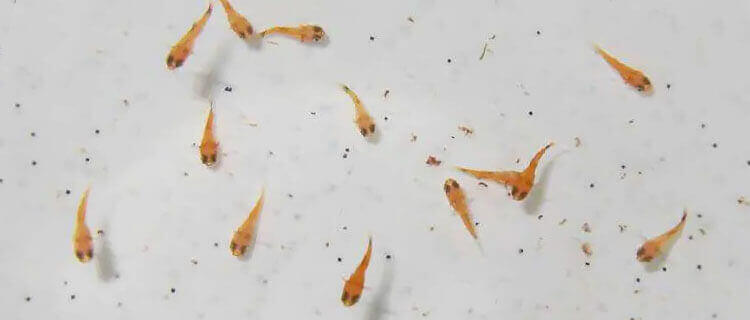
Breeding molly fish is easy, as is the case with many live-bearing species. If one aims to breed them, the male to female ratio should be 1:3. For every three female mollies, one male fish will suffice. Setting up a separate aquarium for breeding is essential for the well-being of the fry.
After mating, ensure that the pregnant female molly is well-fed and protected from attacks by other fish. The simplest method to encourage breeding is to raise the water temperature by about 2 degrees above its normal level.
How Can You Tell if a Molly Fish is Pregnant?
Determining if a molly fish is pregnant relies entirely on observation. After mating, the female will undergo several noticeable changes, particularly in the abdominal region. You can observe based on the following pregnancy signs:
- Swelling and enlargement of the abdomen.
- A distinct black gravid spot on the abdomen (difficult to notice in black mollies).
- Frequent hiding.
- Being chased by male mollies.
- Exhibiting signs of stress (swimming rapidly and evasively).
- Visible fry inside the abdomen (in the last days of pregnancy).
Below in the image, you can see a pregnant molly fish:

How Many Days Until a Molly Fish Gives Birth?
Once a molly fish starts showing signs of pregnancy, the gestation period typically ranges from 35 to 45 days. Depending on the stress levels, water, and environmental conditions, your molly fish will give birth within 35 to 45 days.
Moment of Molly Fish Giving Birth
To witness the birthing process and understand what you should do during this time, you should watch the video below. If the aquarium lacks hiding spaces and has a high number of fish, the birthing process could be challenging.
When preparing for a molly fish to give birth, it’s essential to provide a safe environment. Pregnant mollies should ideally be separated into a breeding tank or a tank with a lot of hiding spaces to ensure the safety of the fry once they are born.
Diseases
Molly fish are generally hardy aquarium inhabitants. However, like all species, they have a few diseases to which they are particularly susceptible:
White Spot (Ich):
This disease, caused by a specific parasite, is common among many aquarium fish. Early treatment will ensure a quicker and less painful recovery for the fish. For more information and treatment on this disease, see: [White Spot Treatment].
Fin and Tail Rot:
This disease is seen in many livebearers. It often results from overcrowded tanks, leading to poor water quality. For more information and treatment on this disease, see: [Fin Rot Treatment].
Velvet (Oodinium) Disease:
Caused by the parasite named Oodinium, this disease settles on and under the fish’s skin, giving it a yellow, rusty appearance. One of the most noticeable symptoms is the fish rubbing itself on various surfaces. For more information and treatment on this disease, see: [Velvet Disease Treatment].
FAQs
Do Molly Fish Eat Their Own Fry?
Yes, molly fish can eat their own fry after giving birth. This behavior is not uncommon among many species of fish. In an aquarium setting, the young fry are at risk from not only their parents but also other adult fish present in the tank. It’s a natural predatory instinct and also a mechanism to control population in confined spaces.
To protect the fry, it’s essential to provide plenty of hiding places in the aquarium. Dense aquatic plants, caves, and other structures can offer the fry places to hide and escape from larger fish. If you are keen on raising the fry to adulthood, consider moving them to a separate breeding or nursery tank immediately after birth. This will give them a safe environment to grow without the threat of being eaten.
How Many Chromosomes Do Molly Fish Have?
Molly fish have 46 chromosomes. This is an interesting fact as they have the same chromosome count as humans. This fish species is one of the organisms that share the same chromosome number as us, making it a frequently mentioned trivia in textbooks and quizzes.





